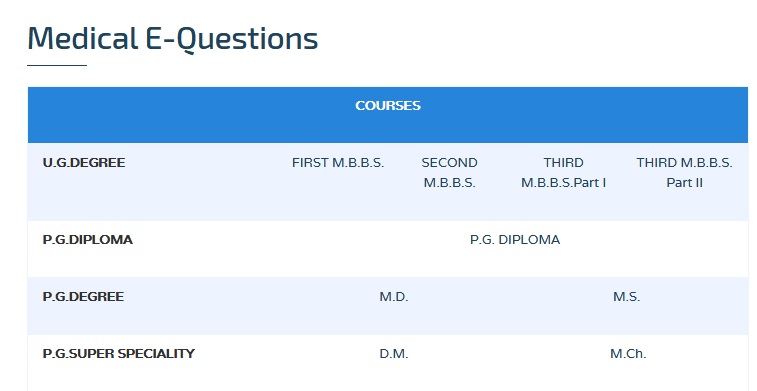Physical Pharmaceutics B.Pharm Question Bank : web.tnmgrmu.ac.in
Name of the University : The Tamilnadu Dr. M.G.R. Medical University
Degree : B.Pharm
Subject Code/Name : 4256/Physical Pharmaceutics
Year : II
Paper : I
Document Type : Question Bank
Website : web.tnmgrmu.ac.in
TN MGRMU Physical Pharmaceutics Question Paper
[KZ 4256] Sub. Code : 4256
Related / Similar Question Bank :
TNMGRMU B.Pharm Biostatistics Question Bank
SECOND B.PHARM. EXAMINATION
Paper I : PHYSICAL PHARMACEUTICS
Q.P. Code : 564256
Time : Three hours
Maximum: 100 Marks

August 2011
Answer ALL questions. :
I. LONG ESSAYS (2 x 20 = 40)
1. a) Explain Critical micellar concentration, theories of micelle formation.
b) Electrical properties of interfaces.
2. Write about the various decomposition and stabilization study of medicinal agents.
II. SHORT NOTES (8 x 5 = 40)
1. Noyes Whitney equation.
2. Colloidal properties.
3. Settling of suspensions.
4. First order reaction.
5. Explain the term Micromeritics.
6. Pharmaceutical applications of Rheology.
7. Give a brief account of inclusion compounds.
8. pH determination and its applications.
Download Model/Sample Question Paper :
2011-2014 :
https://www.pdfquestion.in/uploads/web.tnmgrmu.ac.in/PHARMACY/3748-564256KZ.pdf
III. SHORT ANSWERS : (10 x 2 = 20)
1. Define diffusion.
2. Types of colloids.
3. Deflocculating agents.
4. Factors influencing the physical stability of emulsion.
5. Accelerated stability studies.
6. Methods of determining surface area.
7. Newtonian system. 8. Binding equilibria.
9. Give examples for polymer complexes.
10. Define sedimentation volume.

August 2012
(180 Min)
Answer ALL questions in the same order. :
I. Elaborate on:
1. a. Define interfacial tension? Discuss the classification & application of surfactant?
b. Explain about types of colloids.
2. a. What is menat by Rheology? Give an account of shear thickening system?
b. Write briefly about various methods of determining particle size.
II. Write notes on:
1. Noyes Whitney equation.
2. Spreading coefficient.
3. Cup and Bop viscometer.
4. Diffusion layer model theory.
5. Controlled flocculation.
6. How do you predict shelf life.
7. Define micro meritics. Discuss the applications.
8. Inclusion complexes.
III. Short Answers:
1. Define Emulsion.
2. Yield value.
3. Dielectric constant.
4. Zero order reactions.
5. Stability of emulsion.
6. Polymorphism.
7. Kraft.
8. Kinematic viscosity.
9. Specific gravity.
10.Porosity.
February 2013
(180 Min)
I. Elaborate on: (2 x 2 0 = 40 marks)
1. Describe about the different methods of analysis of complexes with examples.
2. Discuss about the preparation and evaluation of pharmaceutical suspensions.
II. Write notes on: (8 x 5 = 40 marks)
1. Explain the principles of gastro intestinal absorption of drugs.
2. What is buffer capacity? How do you determine the buffer capacity?
3. Describe the derived properties of powders.
4. Write the applications of rheology in pharmacy.
5. Explain the factors influencing rate of reaction.
6. Write notes on spreading coefficient.
7. Discuss about instabilities of emulsion.
8. Describe the optical properties of colloids.
III. Short Answers: (10 x 2 = 20 marks)
1. Half life.
2. Thixotropy.
3. Protein binding of drugs.
4. Applications of colloidal system.
5.Solubilization.
6. Hydrophilic lipophilic balance.
7.Viscosity.
8. Multiple emulsions.
9. Protective colloids.
10. Examples of pharmaceutical buffers.
August 2013
I. Elaborate on: (2X20=40)
1. a) Explain objectives, procedures and limitations of accelerated stability testing.
b) Explain briefly on degradation and stabilization of pharmaceutical products.
2. What is complexation and brief about different types of complexes?
Explain any two methods of complex analysis.
II. Write notes on: (8X5=40)
1. Briefly explain the diffusion principles in biological systems
2. Write short notes on different colloidal systems
3. Explain protein binding of drugs.
4. Discuss Sedimentation technique that used for particle size analysis.
5. Describe Cone and Plate viscometer
6. Explain instabilities of emulsion
7. Explain pharmaceutical applications of surfactants according to HLB values.
8. Discuss shear thickening systems with suitable examples.
III. Short Answers on: (10X2=20)
1. Factors causing breaking in emulsion
2. Zeta potential
3. Noyes Whitney equation
4. Define Yield value in plastic systems
5. Thixotrophy
6. Porosity
7. Define Glidants with suitable examples.
8. Buffer capacity
9. Dissolution
10. Factors influencing CMC
February 2014
I. Elaborate on : (2X20=40)
1. a) Define suspensions. Explain setting properties of suspensions.
b) Explain different types colloids.
2. a) Define thioxtrophy. Types of thioxtrophy. Measurement and application of thioxtrophy.
b) Write about the flow properties of powder.
II. Write notes on : (8X5=40)
1. Explain the electric double layer of interface.
2. Write about the applications of surfactant.
3. Short notes on Inclusion complexes.
4. Write the methods to determine the order of reaction.
5. Explain coulter counter apparatus.
6. Isotonic solutions.
7. Fick’s laws of diffusion.
8. Theories of emulsion.
III. Short Answers on : (10X2=20)
1. CMC.
2. Chelates.
3. Ferrocene.
4. Rheopexy.
5. Noyes-Whitney equation.
6. Surface and interfacial tension.
7. Edmunson equation.
8. HLB.
9. AST.
10. Flocculation and coalescence.
I want all questions paper o f2nd year as per PCI syllabus.
I want 2nd year question bank for physical pharmaceutics.
Medical E-Questions are available in the below link.
tnmgrmu.ac.in/index.php/library/e-questions/medical-e-questions.html
Please send me the important questions in all chapters of pharmaceutics second year.
I want total year question bank of 2yr subject
I want to view the question bank for 2nd year.